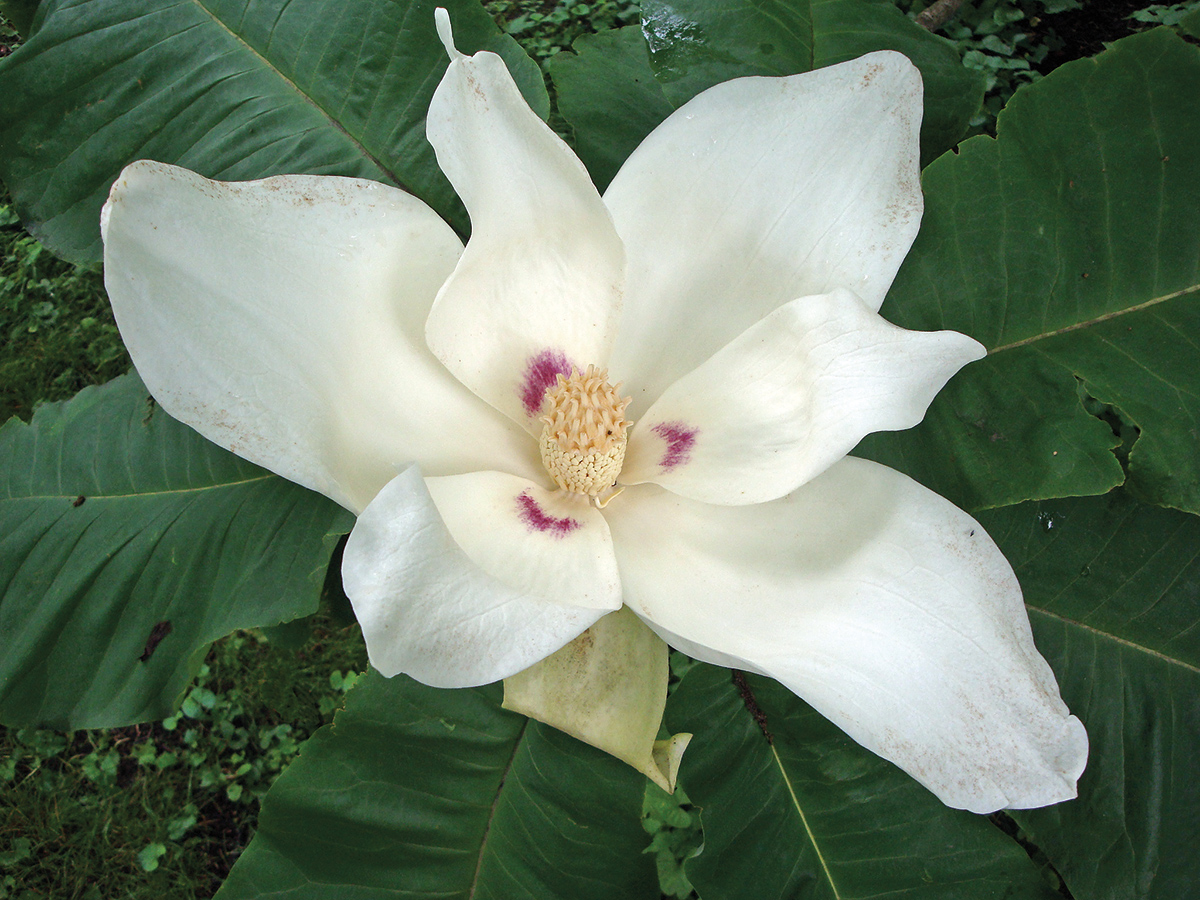
In a living collection comprising thousands of distinctive plants from around the world, bigleaf magnolia (Magnolia macrophylla) makes quite a big impression. Living up to its common and scientific names (“macrophylla” literally means “big leaf” in Latin), bigleaf magnolia bears the largest simple leaf (up to 30 inches long) and flowers (up to a foot in diameter) of any temperate North American tree. These outsized attributes hint at the tree’s ancient evolutionary history, a legacy now threatened by the severely limited scope of its natural range. In fact, the unique ornamental qualities and relative rarity of the species made bigleaf magnolia among the prized targets in the Arboretum’s collaborative expedition to the Southeastern U.S. in fall 2016.
Discovered in 1789 near Charlotte, North Carolina, by French naturalist and explorer Andre Michaux (1746–1802), M. macrophylla occurs in natural populations from southern Ohio to the Gulf Coast, but it isn’t really common anywhere. It grows at a moderate rate into a medium-sized (30–50 feet tall) tree, pyramidal in habit but prone to developing a spreading, rounded crown in maturity. Its giant flowers—fragrant, open, and cup-shaped—bloom in May, and are white with a distinctive rose-purple stain at the base. Pollination is carried out not by bees or butterflies but by beetles attracted to its strong fragrance, another indicator of its primitive past. Flowers give way to ovoid, cone-like aggregate fruits about three inches in length that mature to red in late summer and release red-coated seeds that attract birds. Leaves are a rich green above and silvery-gray below, and may turn yellow in autumn before defoliating.
Though its large leaves command attention when grown as a specimen plant, they make it a considerably less attractive choice as a street tree because of leaf litter in fall. This quality, along with shallow roots that make it difficult to garden beneath, make it best suited to a natural area. It is somewhat shade-tolerant, but can also grow in full sunlight. A location offering moist, loamy soil is preferred because M. macrophylla can suffer during droughts.
At the Arboretum, you may visit eleven accessions of bigleaf magnolia. Look for three young specimens growing amid the Arboretum’s extensive magnolia collection behind the Hunnewell Building, and visit a number of mature specimens along Valley Road near the Centre Street Gate in the hickory collection. Enjoy the sizable charms of a fascinating relict of evolution this growing season at the Arboretum, and keep an eye out for our latest acquisitions of bigleaf magnolia gathered as part of the Campaign for the Living Collection to be planted out in the landscape in coming years.
Originally appeared in the Spring/Summer 2017 [pdf] issue of Silva.
From “free” to “friend”…
Established in 1911 as the Bulletin of Popular Information, Arnoldia has long been a definitive forum for conversations about temperate woody plants and their landscapes. In 2022, we rolled out a new vision for the magazine as a vigorous forum for tales of plant exploration, behind-the-scenes glimpses of botanical research, and deep dives into the history of gardens, landscapes, and science. The new Arnoldia includes poetry, visual art, and literary essays, following the human imagination wherever it entangles with trees.
It takes resources to gather and nurture these new voices, and we depend on the support of our member-subscribers to make it possible. But membership means more: by becoming a member of the Arnold Arboretum, you help to keep our collection vibrant and our research and educational mission active. Through the pages of Arnoldia, you can take part in the life of this free-to-all landscape whether you live next door or an ocean away.
